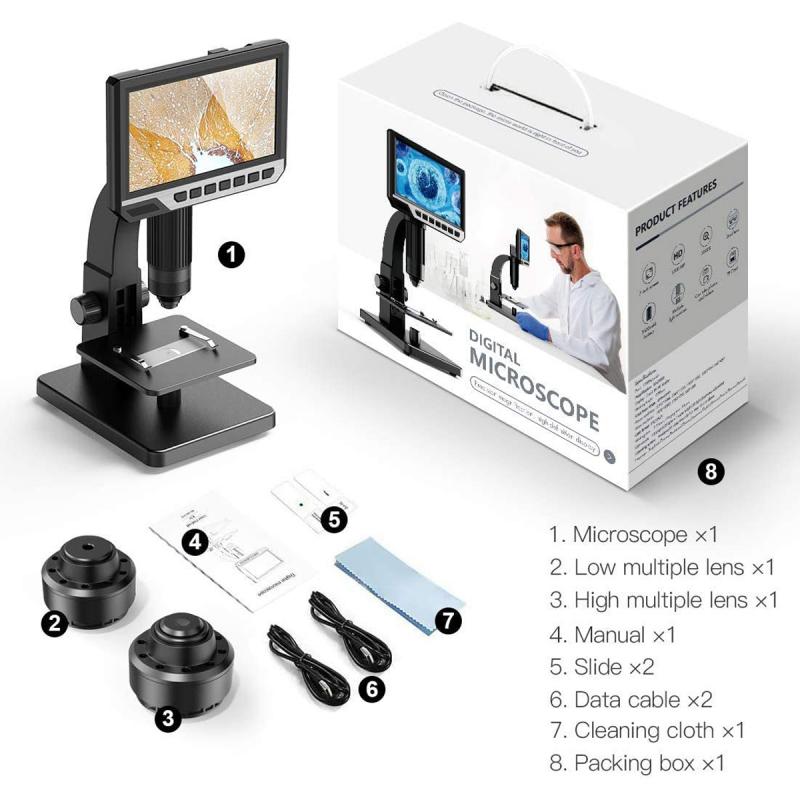How Has The Microscope Advanced Scientific Knowledge ?
The microscope has advanced scientific knowledge by allowing scientists to observe and study objects at a microscopic level. It has enabled the discovery of cells, microorganisms, and other tiny structures that were previously unknown. The microscope has also facilitated breakthroughs in various scientific fields, such as biology, medicine, and materials science, by providing detailed insights into the structure and behavior of microscopic entities.
1、 Discovery of Microorganisms
The microscope has played a crucial role in advancing scientific knowledge, particularly in the discovery of microorganisms. Before the invention of the microscope, these tiny organisms were invisible to the naked eye, and their existence was largely unknown. The microscope allowed scientists to observe and study microorganisms, leading to groundbreaking discoveries and a deeper understanding of the microbial world.
One of the most significant contributions of the microscope to the discovery of microorganisms was made by Antonie van Leeuwenhoek in the 17th century. Using a simple microscope of his own design, he observed and described various microorganisms, including bacteria and protozoa. This marked the beginning of microbiology as a scientific discipline.
Since then, the microscope has continued to advance scientific knowledge in the field of microbiology. It has enabled scientists to identify and classify different types of microorganisms, study their structure and function, and understand their role in various biological processes. Microscopes with higher magnification and resolution have allowed for more detailed observations, leading to the discovery of new microorganisms and the exploration of their intricate world.
In recent years, advancements in microscopy techniques have further revolutionized our understanding of microorganisms. For example, the development of electron microscopy has allowed scientists to visualize microorganisms at an even smaller scale, revealing their ultrastructure and providing insights into their cellular organization. Additionally, fluorescence microscopy techniques have enabled the visualization of specific molecules within microorganisms, facilitating the study of their metabolic pathways and interactions with their environment.
Furthermore, the integration of microscopy with other technologies, such as genomics and proteomics, has opened up new avenues for studying microorganisms. This interdisciplinary approach has led to the identification of novel microbial species, the characterization of their genetic makeup, and the exploration of their potential applications in various fields, including medicine, agriculture, and environmental science.
In conclusion, the microscope has been instrumental in advancing scientific knowledge regarding microorganisms. From the initial discovery of these invisible organisms to the latest advancements in microscopy techniques, the microscope has allowed scientists to explore the microbial world, unravel its mysteries, and harness its potential for the betterment of society.

2、 Understanding Cellular Structure
The microscope has played a crucial role in advancing scientific knowledge, particularly in the field of understanding cellular structure. By allowing scientists to observe and study cells at a microscopic level, the microscope has revolutionized our understanding of the building blocks of life.
One of the key contributions of the microscope to scientific knowledge is the discovery of cells themselves. In the 17th century, the invention of the compound microscope by Antonie van Leeuwenhoek enabled the observation of microorganisms, leading to the realization that living organisms are composed of cells. This breakthrough laid the foundation for the field of cell biology and provided a fundamental understanding of the basic unit of life.
Furthermore, the microscope has allowed scientists to delve deeper into the intricate structures within cells. With the development of more advanced microscopes, such as the electron microscope, scientists have been able to visualize and study organelles, such as the nucleus, mitochondria, and endoplasmic reticulum, in great detail. This has led to significant advancements in our understanding of cellular processes, including DNA replication, protein synthesis, and cellular respiration.
In recent years, advancements in microscopy techniques have further expanded our knowledge of cellular structure. Super-resolution microscopy, for example, has allowed scientists to surpass the diffraction limit of light, enabling the visualization of structures as small as individual molecules within cells. This has provided unprecedented insights into cellular dynamics and interactions, shedding light on complex processes such as cell signaling and intracellular transport.
In conclusion, the microscope has been instrumental in advancing scientific knowledge of cellular structure. From the discovery of cells themselves to the visualization of organelles and molecular interactions, the microscope has revolutionized our understanding of the intricate world within cells. With continued advancements in microscopy techniques, we can expect even greater discoveries and insights into the complexities of cellular structure and function.

3、 Advancements in Medical Diagnostics
The microscope has played a crucial role in advancing scientific knowledge in the field of medical diagnostics. By allowing scientists and medical professionals to observe and study microscopic organisms and structures, the microscope has revolutionized our understanding of diseases, their causes, and their treatments.
One of the key contributions of the microscope to medical diagnostics is the ability to identify and study pathogens. Microorganisms such as bacteria, viruses, and parasites that cause diseases are often too small to be seen with the naked eye. The microscope has enabled scientists to visualize these pathogens, study their morphology, and understand their life cycles. This knowledge has been instrumental in the development of effective diagnostic tests and treatments for various infectious diseases.
Furthermore, the microscope has facilitated the study of cellular structures and functions. By observing cells under high magnification, scientists have been able to identify abnormalities and changes that are indicative of diseases such as cancer. This has led to the development of diagnostic techniques such as cytology and histopathology, which involve the examination of cells and tissues under a microscope to detect and diagnose diseases.
In recent years, advancements in microscopy technology have further enhanced our understanding of diseases. For example, the development of fluorescence microscopy has allowed scientists to label specific molecules or structures within cells, making them easier to visualize and study. This has led to breakthroughs in understanding the mechanisms of diseases at the molecular level, paving the way for targeted therapies and personalized medicine.
Moreover, the integration of microscopy with other technologies, such as molecular biology and computer imaging, has opened up new avenues for medical diagnostics. Techniques like confocal microscopy and electron microscopy, combined with advanced image analysis algorithms, have enabled researchers to obtain detailed three-dimensional images of cells and tissues, providing valuable insights into disease processes.
In conclusion, the microscope has significantly advanced scientific knowledge in the field of medical diagnostics. Its ability to visualize and study microscopic organisms and structures has revolutionized our understanding of diseases and has led to the development of effective diagnostic techniques and treatments. With ongoing advancements in microscopy technology, we can expect further breakthroughs in medical diagnostics, ultimately leading to improved patient care and outcomes.

4、 Unveiling Nanoscale World
The microscope has played a pivotal role in advancing scientific knowledge by allowing scientists to explore and understand the nanoscale world. By magnifying objects to a level that is invisible to the naked eye, microscopes have revolutionized our understanding of the smallest building blocks of life and matter.
One of the most significant contributions of the microscope has been in the field of biology. It has enabled scientists to observe and study cells, bacteria, and viruses, leading to groundbreaking discoveries in the understanding of diseases and the development of new treatments. For example, the discovery of bacteria and their role in causing infections was made possible through the use of microscopes. Similarly, the study of cells and their structures has provided insights into the mechanisms of life and the development of organisms.
In recent years, advancements in microscopy techniques have further expanded our understanding of the nanoscale world. For instance, the development of electron microscopes has allowed scientists to visualize objects at an even higher resolution, revealing intricate details of atomic and molecular structures. This has led to breakthroughs in fields such as materials science, where scientists can now manipulate and engineer materials at the atomic level to create new and improved products.
Furthermore, the advent of scanning probe microscopes, such as atomic force microscopy, has enabled scientists to study and manipulate individual atoms and molecules. This has opened up new avenues in nanotechnology, where researchers can design and fabricate nanoscale devices with precise control over their properties.
In conclusion, the microscope has significantly advanced scientific knowledge by unveiling the nanoscale world. From the discovery of bacteria to the exploration of atomic structures, microscopes have provided invaluable insights into the fundamental building blocks of life and matter. With continued advancements in microscopy techniques, we can expect further breakthroughs in various scientific disciplines, leading to new discoveries and innovations.





























